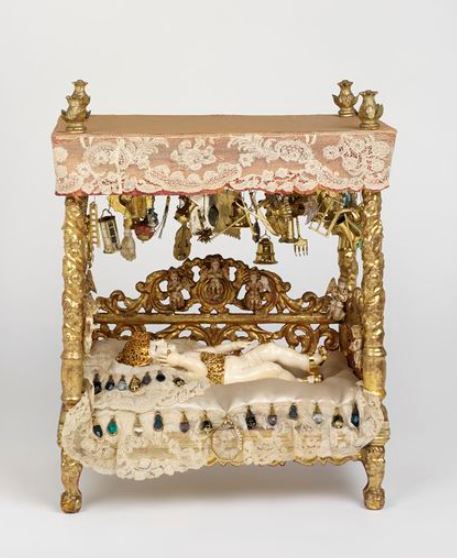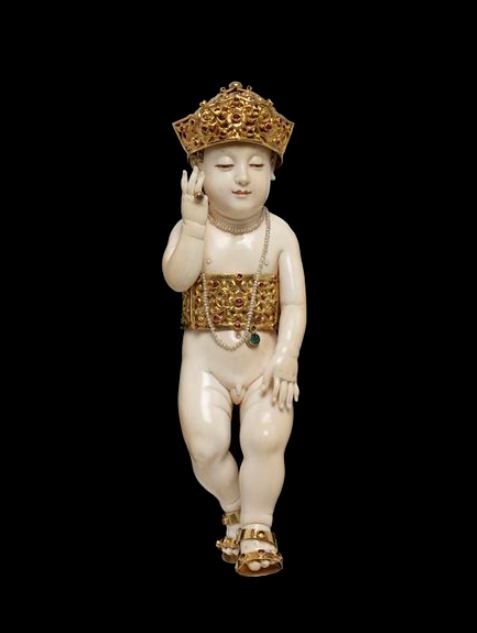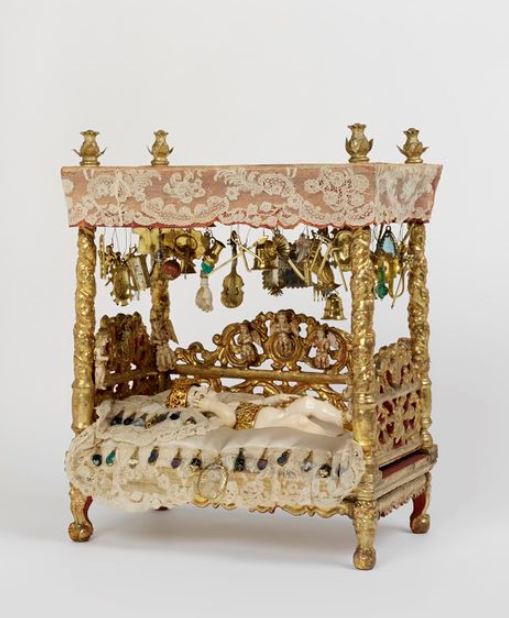The Buddha/Bambino of Burmah

Carved ivory Burmese Bambino Buddha http://collections.vam.ac.uk/item/O451098/image-of-the-infant-christ-object/
The apocryphal Infancy Gospel of Thomas is sometimes called the “Malevolent Acts,” as it depicts the Child Jesus as a miracle-working but essentially spiteful and cruel character. In one episode, the young Jesus curses a boy, causing his death.
Today we hear from an English society hostess who owned an antique ivory figure of the Christ Child, which seemed to have a similarly problematic personality.
Though I am not by any means particularly superstitious, some occurrences which once took place in my own house really did cause me alarm.
A great friend of mine had presented me with a most lovely gift, a Bambino, or Holy Child, carved out of ivory. It came, I believe, from Burmah, and the face was that of a Buddha ; on its head was a crown of gold, and there were also rings upon its fingers.
This Bambino lay upon a beautiful miniature four-poster bed, and all around it hung Neapolitan and Burmese charms. The little figure, indeed, seemed as if it might be as sacred to a Buddhist as to a Christian. It had been brought by missionaries from Burmah, where it had been worshipped as the infant Buddha, to Naples, and there become an object of veneration to Catholics. There was something very fascinating and striking about this Bambino which could not fail to rivet the attention, and, delighted to receive such a unique gift, I at once gave the glass case which contained it the place of honour in my drawing-room. There it lay, dignified and peaceful to all outward appearance, but in reality, as we subsequently discovered, anything but pleased at finding itself amidst such incongruous surroundings.
From the day the Buddha entered my house everything went amiss. As a matter of fact, I do not believe it hated me as much as it did my family, though eventually it did not forget to give me a very startling manifestation of its displeasure. Its installation in the drawing-room was soon followed by a perfect avalanche of catastrophes. Within a week, to begin with, a son of mine in the City wrote informing me that he had of late met with nothing but bad luck, everything having gone wrong; several of his best clients had died, whilst others had either left England or for the time being given up doing any business.
A day or two later my daughter was walking in Berkeley Square with her dog, to which she was very devoted, when a collie deliberately stalked up, took it between its teeth, shook it like a rabbit, then, leaving it on the ground dead, trotted off before the tragedy had been thoroughly realized. In addition to this, one of her ponies was suddenly paralyzed in its stable, and this on the very eve of an election, in which she was most anxious to help by conveying Conservative voters to the poll.
Disaster now followed disaster, my other sons writing to say that a strange vein of ill-luck had suddenly begun to pursue them; indeed, a black cloud seemed to have settled over the whole family.
Then it was that someone suggested that perhaps the Buddha was unlucky, his feelings being outraged at his frivolous surroundings, for Buddhas were not used to drawing-rooms. I was even advised to propitiate the little image by putting lotus-leaves before it; but where could they be got? I do not believe that lotus-leaves are to be procured in London, not even in Covent Garden Market, and as a substitute might have made the little image even more angry than it was, I decided to do nothing; besides, I rather scouted the idea that it was the Buddha which was bringing bad luck. My opinion, however, changed when, a few days later, an immense chimney, constructed of the most solid masonry, came down with a crash upon a projecting wing at the back of my house, and carried away several water-tanks and three-quarters of the bathroom, as well as doing a great deal of other damage in the way of broken windows and the like. There was no reason why the chimney in question should have selected my house to come down upon, and it seemed as if this fall had been a deliberate choice.
I now seriously began to think that the Buddha would be better somewhere else than with me, for it seemed evident that his present quarters were anything but to his liking, and so I set about pondering as to what could be done. I did not wish to give the image away; in the first place, it might offend my friend who had presented it to me, and, in the second, such action might entail the ruin of the innocent recipient, while to sell Buddha was of course, out of the question.
At last I hit upon a solution, which was to place it in the Victoria and Albert Museum at South Kensington, and with this design in view I proceeded to apply to a friend of mine who at that time presided over the destinies of the institution in question.
This was Sir Purdon Clarke, ever to me the most accommodating and obliging of men. In the matter of the Buddha, however, he said he could not assist me, there being no chance of the little deity being admitted into the Museum. I believe that the regulations really did prohibit the admission of such an exhibit; but even had they not done so, I don’t think Sir Purdon would have taken it, for I had incautiously detailed the catalogue of misfortunes which had occurred to us since its advent, and he naturally had no wish to admit such an uncertain-tempered occupant into galleries which it might have wrecked.
At the same time he suggested a solution, which was to take the Buddha to the Indian Museum, where the authorities would be delighted to take care of it for me; this I accordingly did, and it was agreed that the little god should be given a place as a loan exhibit. I must add that I said nothing about its temper, as Sir Purdon had warned me not to mention anything of my misfortunes, lest it should reach the ears of the Italian workmen, many of whom were employed about the place; these men, said he, were exceedingly superstitious, and would bitterly resent the advent of such an irascible visitor.
Since then I have not made any inquiries about the Buddha, which is still at the Indian Museum, but I heard rumours some little time after its arrival that things were not going well; I believe the Italian workmen did strike, whilst some other unfortunate occurrences took place. However, for many years I have heard of no further disasters, and so have good reason for thinking that the wrath of this exile from a far country is at length appeased.
I was told of a mummy which, having been presented to the British Museum, behaved much in the same way as did my Buddha. When this mummy was being carried in, the men who bore it tumbled over, one of them breaking a limb, whilst misfortune after misfortune happened in the particular section where the new arrival was placed. Eventually, however, the irate arrival was placated, for, it being discovered that it or rather she, was an Egyptian Queen, someone made the suggestion that perhaps irritation at not being accorded royal honours was the cause of all the disasters which had occurred since her advent, and accordingly she was placed in a case containing the mummy of another Egyptian Queen, one who had been a monarch of especial note and power. Immediately this had been done everything went right again, the outraged feelings of the sensitive though mummified ruler being apparently mollified by such a mark of respect.
The Reminiscences of Lady Dorothy Nevill, 1907
Ah, the old “I-am-not-superstitious-but…” opening gambit! That said, Sir Purdon showed himself a man of sound good sense; he knew from the stories about the “evil mummy” of the British Museum that cursed objects don’t belong in a modern educational institution. On the other hand, the Indian Museum, well-known as a jumbled cabinet of bizarre Asian curiosities, as well as the home of the Tipu Sahib tiger-devouring-an-Englishman automaton, was the perfect place for the ambiguous ivory figure.
Judging from Lady Dorothy’s description, I would have expected the image to have been of the “Goa” school: a carving made by Indian Christians after Iberian models, but with a definite eastern flavor. Sadly, I assumed I would never know because the Indian Museum closed in 1879 and many of its curiosities were sold off. But much to my surprise, I found the image properly catalogued and photographed at the Victoria & Albert, which absorbed the cream of the Indian Museum’s collections.

The Burmese Bambino Buddha http://collections.vam.ac.uk/item/O451098/image-of-the-infant-christ-object/
It is a beautiful and intriguing object indeed! The serene image, in his Burmese crown, ring, belt, and shoes, (He may have originally been dressed in an elaborate robe.) lies on hand-made 18th-century lace bedding; his little gilt bed, in the Portuguese style, is hung with both Christian and Buddhist charms. I’ve previously written about the devotional cribs of the Infant Jesus hung with toys and bells to amuse the Divine Child, but the mixture of Christian and Buddhist charms is, to the best of my knowledge, unprecedented. An apparent copy of the image described as 16th or 17th century was sold in 2012 at Christie’s Paris.
Here is a note on provenance from the Victoria and Albert Museum’s web page:
A note written by the donor at the time of presentation and attached to the case containing the object said ” The Bambino Buddha was brought to Rome from Burmah by a Catholic Missionary of the Talbot family in 1600. This Bambino Buddha was worshipped in Burma as a Buddha and in Rome as Christ. The different amulets, Indian and Christian, seem to corroborate this notion”.
I wish I could see details of the many charms; in all likelihood they are ex-voto offerings, rather than objects to amuse the Child.

Burmese Bambino Buddha in bed. http://collections.vam.ac.uk/item/O451098/image-of-the-infant-christ-object/
The museum website does not mention any ill-effects from the image, which, one would think, would have preferred a convent where He could be doted upon by the nuns. But perhaps, like ghosts, psychic malevolence has a statute of limitations. It may also have been that Lady Dorothy’s household was simply out of sympathy with the figure; as a young woman she had had her reputation compromised by a cad and while she was a much sought-after political hostess, she was never received at court by Queen Victoria because of the scandal. Perhaps the tolerant Saviour who told the woman caught in adultery to “go, and sin no more,” was less broad-minded in His youth.
Other stories of cursed religious images, particularly of mixed cultures? Send to chriswoodyard8 AT gmail.com.
Chris Woodyard is the author of The Victorian Book of the Dead, The Ghost Wore Black, The Headless Horror, The Face in the Window, and the 7-volume Haunted Ohio series. She is also the chronicler of the adventures of that amiable murderess Mrs Daffodil in A Spot of Bother: Four Macabre Tales. The books are available in paperback and for Kindle. Indexes and fact sheets for all of these books may be found by searching hauntedohiobooks.com. Join her on FB at Haunted Ohio by Chris Woodyard or The Victorian Book of the Dead. And visit her newest blog, The Victorian Book of the Dead.
